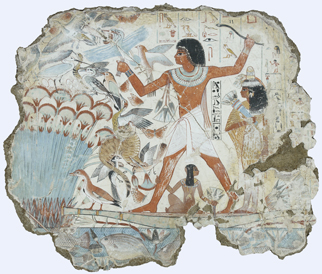10 Symbolic dimension
It is interesting here to note another point that serves to draw us further away from a naively naturalistic reading of the Nebamun tomb-chapel paintings: that disposition that tends to see a painting such as the surviving fragment of ‘Hunting in the marshes’ (Figure 38) as representing a sort of archaic snapshot of an agreeable picnic on the banks of the river – Mum all dressed up for the day, Dad a fine physical specimen, the kids frolicking around near the water, and a family pet splashing around and chasing the birds.

Waving goodbye to all that, we begin to grasp the symbolic dimension that coincides with, and perhaps even determines, those naturalistic aspects of the image to which we are more readily attuned. These include, on the one hand, a celebration of fertility and fruitfulness – the location of the marsh being associated with the goddess of fertility Hathor. And on the other hand, the figure of Nebamun vanquishing wild creatures representative of the forces of chaos and disorder, enacting the struggle of Horus and Seth; the cat with its golden eye perhaps an allusion to the sun god; the whole scene encapsulating a life well lived, before entering upon the afterlife in the garden of the west.
We have seen how highly conventionalised are the ‘stylistic’ or ‘syntactical’ aspects of Egyptian art. Now we can also appreciate the conventional nature of its subject matter: how scenes of ‘daily life’ carry ‘underlying messages of regeneration and rebirth’. As the British Museum handbook states: ‘the purpose of all these scenes and texts remains constant: to procure eternal life for the owner’. (p. 196)
